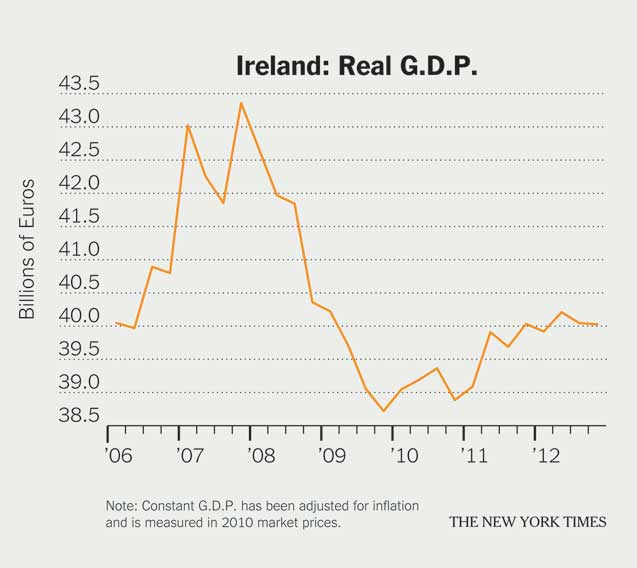In a recent syndicated column, the economist Jean Pisani-Ferry had a generally reasonable discussion of the problems with the “troika” (made up of the European Central Bank, the European Commission and the International Monetary Fund) that has managed European rescue policies.
But I was struck by this: “Three years later, the results are mixed at best,” he wrote. “Unemployment has increased much more than anticipated and social hardship is unmistakable. There is one bright spot: Ireland, which is set to recover from an exceptionally severe financial crisis. But there is also a dark spot … “
What’s the Irish for “Et tu, Jean”? As best I can tell, Ireland has been universally (that is, by all the Serious People) proclaimed a successful role model at least once a year since the crisis began. Meanwhile, unemployment remains spectacularly high, although down a bit.
See the chart on this page. This is a “bright spot”?

True, in his column Mr. Pisani-Ferry doesn’t actually say that Ireland is recovering, only that it is “set to recover.” But we’ve heard that before, and before, and before. And much of the data that is used to tell the recovery story is suspect — not because it’s wrong, exactly, but because of Ireland’s odd economic structure, in which so much of the nation’s reported exports come from companies that add little value to its economy, which means that the usual numbers have to be treated with great caution.
So look: maybe Ireland really is going to recover soon, for real. Let’s hope so. But the repeated declarations that this is already a success story — which we’ve been hearing for at least three years — are just weird.
And yes, it seems obvious to me that Ireland keeps being proclaimed a success because it’s supposed to be a success: they did the austerity thing forcefully, with a minimum of complaints, so there must be a pot of gold at the end of that rainbow, right?
Debt and Growth: The State of the Reinhart-Rogoff Debate
There are three points that have been established in the debate about the paper written by the Harvard economists Carmen Reinhart and Ken Rogoff, which officials have used to justify austerity policies. I’m not sure that everyone understands that any one of those points is enough to refute most of the debt/deficit discussion of the past three years.
1. There is no threshold at 90 percent, even though the claim that economies were likely to stagnate when debt levels exceed 90 percent of gross domestic product has dominated a lot of the policy discussion for three years. The appearance of such a threshold in the original paper was an artifact of missing data (not deliberately, and perhaps unavoidably, but that’s not the issue here) plus an odd statistical technique.
2. There is a mild negative correlation between debt and growth. Even if this is interpreted as a causal relationship, however, the correlation is not strong enough to justify the debt panic of recent years. As the economist Brad DeLong wrote in his blog: “as best as I can tell we are talking that an increase in debt from 50% of a year’s G.D.P. to 150% is associated with a reduction in growth rates of 0.1% [per] year over the subsequent five years …”
3. There is pretty good evidence that the relationship is not, in fact, causal, and that low growth mainly causes high debt rather than the other way around.
We’ve spent three years letting unwarranted fears dominate policy decisions.
We’re not backing down in the face of Trump’s threats.
As Donald Trump is inaugurated a second time, independent media organizations are faced with urgent mandates: Tell the truth more loudly than ever before. Do that work even as our standard modes of distribution (such as social media platforms) are being manipulated and curtailed by forces of fascist repression and ruthless capitalism. Do that work even as journalism and journalists face targeted attacks, including from the government itself. And do that work in community, never forgetting that we’re not shouting into a faceless void – we’re reaching out to real people amid a life-threatening political climate.
Our task is formidable, and it requires us to ground ourselves in our principles, remind ourselves of our utility, dig in and commit.
As a dizzying number of corporate news organizations – either through need or greed – rush to implement new ways to further monetize their content, and others acquiesce to Trump’s wishes, now is a time for movement media-makers to double down on community-first models.
At Truthout, we are reaffirming our commitments on this front: We won’t run ads or have a paywall because we believe that everyone should have access to information, and that access should exist without barriers and free of distractions from craven corporate interests. We recognize the implications for democracy when information-seekers click a link only to find the article trapped behind a paywall or buried on a page with dozens of invasive ads. The laws of capitalism dictate an unending increase in monetization, and much of the media simply follows those laws. Truthout and many of our peers are dedicating ourselves to following other paths – a commitment which feels vital in a moment when corporations are evermore overtly embedded in government.
Over 80 percent of Truthout‘s funding comes from small individual donations from our community of readers, and the remaining 20 percent comes from a handful of social justice-oriented foundations. Over a third of our total budget is supported by recurring monthly donors, many of whom give because they want to help us keep Truthout barrier-free for everyone.
You can help by giving today. Whether you can make a small monthly donation or a larger gift, Truthout only works with your support.
